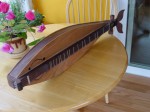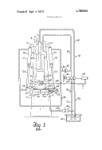My father, Clark John Hamkins (1930 – 2013) passed away May 11, 2013 at his home in Brunswick, Maine. He was a good man, witty, kind, intelligent, honest, hard-working, caring, curious, patient, philosophical, mathematical, practical, fair. The world has just lost a great human being. He was a loving family man, married to my mother, Monica, for 55 years (their wedding anniversary was yesterday), with six children and thirteen grandchildren.
He was an engineer’s engineer, one who could take apart any machine and put it back together and tell you all about the ways in which the design was flawed or how it was clever. I think of his work as a kind of meta-engineering, for he designed the machines for manufacturing a product, bending pipes and twisting wire, rather than the product itself. He held a number of patents for his inventions, including some for his design of a manufacturing apparatus for winding semi-toroidal transformers. When I was a kid, he designed and built in his wood shop a hand-crank centrifugal honey-extractor, which we used to harvest the crop from our bee hives. He taught all his kids their way around a wood shop, how to cut, saw, nail, drill, screw, sand, bore, file, buff, solder, join, plane, dowel, glue, measure, how to use all manner of hand tools and the jig saw, the band saw, the table saw, the mitre saw, the drill press, the belt sander. He was beyond serious, with a lathe in his shop. “Use the right tool for the job,” I can still hear him say, and “measure twice, cut once; measure once, cut twice,” a warning to those who would rush their work. He made all manner of toys for his children and then for his grandchildren. He made cabinets, tools, furniture, items of all kinds, large and small, fine and plain.  He kept and used a wood shop his entire adult life, insisting even in his final days that he go down into it. One of his final projects was to design and build a beautiful, melodious whale-motif dulcimer.
He kept and used a wood shop his entire adult life, insisting even in his final days that he go down into it. One of his final projects was to design and build a beautiful, melodious whale-motif dulcimer.
He was an artist, and as a young man produced oil paintings, which move me to this day. Long ago, before having kids, he made architectural drawings for the family home he had planned, and it is clear in retrospect that he hadn’t planned at that time on having such a large family. (The joke in our family is that Dad wanted four kids and Mom wanted two, and they both got their wish!) Later, he would inevitably win our family games of pictionary, where one is given the task to draw the meaning of a word selected randomly from the dictionary. His drawings always started with a clear simple line, capturing the essence of the concept, which was then fleshed out in fuller artistic flair until his partner said the word. I found an old math book of his, from his own school days, with a chapter on Polar Coordinates in which he had drawn a wonderful Eskimo, carrying a harpoon and fish, and an igloo.
He was a teacher at heart. He explained the slide rule to me when I was young, and gave a lesson on logarithms and log tables and the accompanying explanation of linear interpolation. He explained to me as a child what
He was a programmer, programming computers in the earliest days. I brought his cast-off computer cards, punched paper tapes and so on into my third-grade classroom for show-and-tell. I remember him poring over expansive flowcharts spread across the kitchen table in the evenings. He made sure that his kids were learning how to program.
He was a voracious reader, consuming books in science, philosophy, literature, history, archeology, biology, physics, mathematics. You name it; he read it.
He was a skeptic.
He was a rebel physicist, refusing to accept the conclusion of the Michelson-Morley experiment on relativistic length foreshortening and time contraction. And he backed up his beliefs by writing an account of this part of physics, re-developing the theory from an alternative perspective of his own invention, involving a notion of time translation, which avoided the need for those paradoxical conclusions, but ended up deriving the same fundamental equations.
I will miss him.




Yes, your description so captures him.
In addition to everything you said, I also remember and appreciate his great sense of playfulness, how he could make a game out of ordinary things, like making sandwiches for us or putting us to bed. I remember once when we were camping in Canada, in looking for our pajamas which we had stuffed down in the bottom our of sleeping bags, he dived right inside and pretended the sleeping bags were monsters eating him up.
I also remember the spectacular toys he built for us, the red and yellow airplane on wheels that we could ride around on, our brick sandbox, and the tree house in our backyard that was the center of our imaginary adventures. And then when we each had our first child, he built each of our families a gorgeous wooden high chair and a few years later a little wooden play kitchen.
He was a kind, fun, loving father, and I will miss him.
Pingback: Math for kids: fun with orthoprojections! | Joel David Hamkins